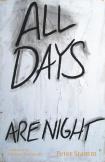Less Is More
More is better in the land of Trump, even in the literary world. Our novelists garnering large advances and recognition write hefty novels chock-full of virtuosic sentences, one after the next. The result can be numbing. Glimmers of truth are obscured by pyrotechnic wordplay, making readers, at least readers like me, feel they are not smart enough to keep up.
Not so reading Peter Stamm, the excellent Swiss novelist and short-story writer, who has built his well-deserved reputation crafting sentences that are extraordinary in their precision and plainness—sentences that compel you with an eerie sense of Hitchcockian dread, as seen in from the start of his crisp, evocative novel, All Days Are Night:
Gillian slowly comes to understand she is in a hospital bed after a car accident that killed her husband and horribly disfigured her. “She closed her eyes and saw the hole in her face through which she had seen inside her head.” Though her surgeon assures her that after he reconstructs her nose she will be able to resume her career as a TV personality, Gillian wonders how she could possibly continue given her responsibility for what happened. Before the accident, her husband, Matthias, had discovered nude photos of her taken by an artist she had interviewed on her TV show. Afterward, she and her husband went to a party where they drank and fought. Gillian knew they shouldn’t drive home.
Unlike a Hitchcock film, this plot summary gives little away. Stamm doesn’t cultivate a sense of dread to heighten the suspense. On the contrary, he shuns the showy and dramatic to simply evoke the truth. “Gillian had always known she was in danger, that she would sometime have to pay for everything. Now she had paid.” The dread Stamm writes about does not come from the fear of psychos wielding knives. It is the real, visceral dread that plagues our mortal existence—the dread that ultimately we don’t have control. And worse, that we are culpable for the tragedies that befall us.
As Gillian gets out of the hospital and heals, we learn the details of her willful flirtation with Hubert, the artist who took the photos. There is a wonderful naturalness to Stamm’s movements back in time as Gillian considers the incidents that led up to the accident, like this scene where she’s sitting naked for her portrait in Hubert’s studio:
But she hadn’t slept with Hubert; there had been just the sittings, the nude photos and their aftermath, along with her lingering confusion and guilt.
The second section of this tripartite novel shifts to the point of view of Hubert, who is suffering from a creative crisis:
Hubert is struggling to create a follow-up show at a mountain resort where he had a great success seven years ago exhibiting a series of life-sized photographs of naked women in everyday poses—naked housewives, his gallerist had called them. Stamm finds no glamour in the artistic journey. He depicts the isolated, often hopeless struggle of an artist groping for a subject—not necessarily one that is profound or meaningful but merely that will hold his interest.
When Hubert meets Gillian before her accident, he hopes that her presence would rekindle the sense of creative unease he felt when he’d started photographing naked women. “It wasn’t so much her nakedness that interested him as the hope that she might be unsettled by it.” But after his sessions with Gillian go nowhere, he reads in the paper she was in a terrible accident and forgets about her.
As the date for his show draws closer, Hubert leaves his girlfriend and young son to travel to the resort empty-handed, to, as he desperately hopes, find inspiration in the mountains. It is painful to watch him idle his days away, drinking and chasing inane ideas, because his self-sabotage feels so real and familiar. Stamm’s themes of identity and artistic purpose converge as Hubert crosses paths again with Gillian, who is head of entertainment at the resort. Their reunion is not a coincidence: Gillian has arranged Hubert’s invitation, to give her a second chance to explore what drew her to the artist in the first place.
A sense of inevitability pervades the dread as Gillian and Hubert’s lives come together and come apart, as real lives do, defying our grasping expectation for permanence. Stamm is no carnival barker. His stories are not larger than life. Nevertheless he demands our attention with his penetrating, artful simplicity, offering glimmers of the truth that resonate and remain.
This article also appeared in print, under the headline “Less Is More ,” in the February 15, 2016, issue.








